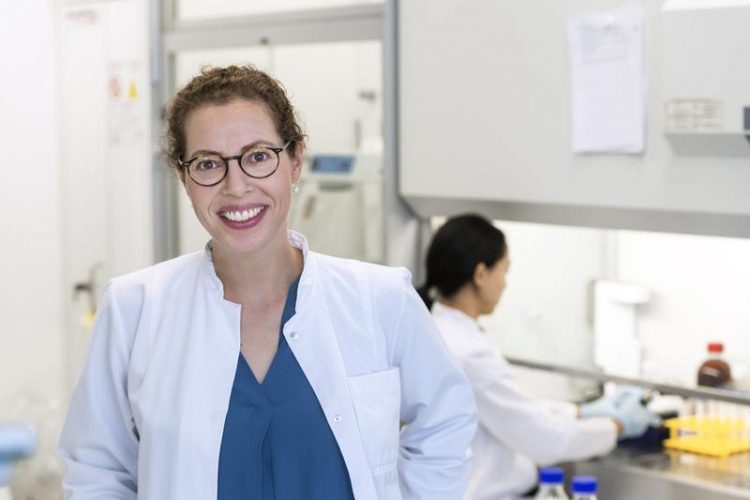Atopic dermatitis: elevated salt concentrations in affected skin

Prof. Christina Zielinski Andreas Heddergott / TUM
In industrial countries, nearly one in three people are affected by allergies at some point in their lives. One in ten children suffer from atopic dermatitis. T-cells play an important role in immune conditions of this kind.
They are a vital aspect of the body's resistance to infections, but, if uncontrolled, can also develop pathological responses and start attacking parts of our bodies or innocuous substances such as allergens.
When such functions occur, Th2 cells, a subgroup of T cells, can cause inflammatory skin conditions such as atopic dermatitis. This involves increased production of the proteins interleukin 4 (IL-4) and interleukin 13 (IL-13). It is still unknown what triggers the signalling malfunction.
More Th2 cells under the influence of sodium ions
Table salt, known scientifically as sodium chloride, is essential to the health of humans and animals. In the body it occurs in the form of sodium and chlorine ions. In a recent study, Christina Zielinski, a DZIF-professor at TUM's Institute of Virology, and her team were able to demonstrate that sodium chloride can induce a state in human T cells that causes them to produce increased amounts of the proteins IL-4 and IL-13.
Types of T-cells, which should not cause allergies, can, in the presence of salt, turn into Th2 cells. The changes are reversed when the T cell is again exposed to lower salt levels. “Consequently, ionic signals do play a role in the generation and control of Th2 cells,” says Christina Zielinski.
Highly elevated salt levels in the skin of patients suffering from atopic dermatitis
As a medical specialist in the field of dermatology, Zielinski is naturally interested in atopic dermatitis. Her team investigated whether the affected skin regions of atopic dermatitis patients exhibit elevated sodium levels.” Measuring sodium concentrations in the tissue is complicated,” explains the first author of the study, Julia Matthias.
“Dissolved salt in blood can be measured using standard clinical methods. But for the skin, we needed the help of colleagues in nuclear chemistry and physics.”
They tested the skin samples at the Research Neutron Source Heinz Maier-Leibnitz (FRM II) at TUM and at the Institute for Nuclear Chemistry at the University of Mainz by means of neutron activation analysis. The sodium levels in the affected skin areas of patients suffering from atopic dermatitis proved to be up to 30 times higher than in healthy skin.
Ideal conditions for bacteria thriving under salty conditions
“The higher sodium levels in the affected skin neatly match another characteristic of atopic dermatitis,” says Christina Zielinski. “It has been known for some time that patients with this condition have elevated levels of the bacterium Staphylococcus aureus on their skin.
These are bacteria, which thrive under salty conditions – in contrast to other commensal bacteria, which are in fact harmed by salt.” Zielinski believes that this insight along with others and the current research results point to a link between salt and the occurrence of atopic dermatitis.
“However, we have not yet been able to show how these large quantities of salt find their way to the skin,” she concedes. “For that reason, we are also unsure of how a low-salt or high-salt diet might be related to the appearance and progression of atopic dermatitis or other allergic conditions.” Professor Zielinski and her team hope to answer these and other questions in future interdisciplinary studies.
More information:
Christina Zielinski's professorship at TUM receives funding from the German Center for Infection Research (DZIF). The research was partly conducted at the Berlin university hospital Charité – Universitätsmedizin Berlin.
• Zielinski Lab: https://zielinskilab.com
• TUM Institute of Virology: https://www.virologie.med.tum.de/en/home/
• German Center for Infection Research (DZIF): http://www.dzif.de/en/
Further information on the neutron activation analysis performed for the study is available on the website of the FRM II research neutron source: https://www.frm2.tum.de/en/industry-medicine/analysis-with-neutrons/
Prof. Dr. med. Christina Zielinski
Technical University of Munich (TUM)
TranslaTUM & Institute of Virology
Tel: +49 89 4140-4134
christina.zielinski@tum.de
J. Matthias, J. Maul, R. Noster, H. Meinl, Y.-Y. Chao, H. Gerstenberg, F. Jeschke, G. Gasparoni, A. Welle, J. Walter, K. Nordström, K. Eberhardt, D. Renisch, S. Donakonda, P. Knolle, D. Soll, S. Grabbe, N. Garzorz-Stark, K. Eyerich, T. Biedermann, D. Baumjohann, C. E. Zielinski. “Sodium chloride is an ionic checkpoint for human TH2 cells and shapes the atopic skin microenvironment.” Science Translational Medicine (2019). DOI: 10.1126/scitranslmed.aau0683
https://mediatum.ub.tum.de/1475815 High-resolution images
Media Contact
All latest news from the category: Life Sciences and Chemistry
Articles and reports from the Life Sciences and chemistry area deal with applied and basic research into modern biology, chemistry and human medicine.
Valuable information can be found on a range of life sciences fields including bacteriology, biochemistry, bionics, bioinformatics, biophysics, biotechnology, genetics, geobotany, human biology, marine biology, microbiology, molecular biology, cellular biology, zoology, bioinorganic chemistry, microchemistry and environmental chemistry.
Newest articles

NASA: Mystery of life’s handedness deepens
The mystery of why life uses molecules with specific orientations has deepened with a NASA-funded discovery that RNA — a key molecule thought to have potentially held the instructions for…

What are the effects of historic lithium mining on water quality?
Study reveals low levels of common contaminants but high levels of other elements in waters associated with an abandoned lithium mine. Lithium ore and mining waste from a historic lithium…

Quantum-inspired design boosts efficiency of heat-to-electricity conversion
Rice engineers take unconventional route to improving thermophotovoltaic systems. Researchers at Rice University have found a new way to improve a key element of thermophotovoltaic (TPV) systems, which convert heat…



